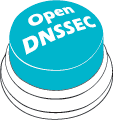OpenDNSSEC 2.0.0
It gives us pleasure to announce the release of OpenDNSSEC 2.0
OpenDNSSEC got a entire re-write of the enforcer. This part of OpenDNSSEC controls changing signing keys in the right way to perform a roll-over. Before, the enforcer would perform a roll-over according to a strict paradigm. One scenario in which deviations would not be possible.
The new enforcer is more aware of the zone changes being propagated in the Internet. It can therefore decide when it is safe to make changes, rather than to rely upon a given scenario. This makes it possible now for OpenDNSSEC to:
- Allow changing your TTL values and all other related parameters in your key and signing policy (KASP). OpenDNSSEC will know which outdated records may still be on the Internet due to their TTL and only roll when it is safe.
- It is possible to safely roll to an unsigned situation, without going bogus.
- Perform a roll-over procedure at any time, even if a roll-over procedure is still in progress, this way you can abort a roll-over and perform emergency roll-overs.
- Perform a roll-over to a different signing algorithm. DNSSEC requires the algorithm number of ZSK and KSK to be the same, so a roll-over to a different algorithm requires a different sequence.
- Since there is no longer a single scenario, it will become possible to perform other roll-over methods, like a double DS roll-over or a double RRSIG roll-over.
These features keep your zone valid even in situations where changing parameters could trap you into a bogus situation. OpenDNSSEC chooses the fastest safe steps to keep (or even heal) your zone. Other features have also been realized in this rewrite:
- Shared keys, allowing multiple zones to share the most recent signing key for that policy. Useful when having many zones, and a limited storage in your HSM.
- Combined keys, allow KSK and ZSK to be the same key, also limiting the usage of keys, but also simplify key usage.
- Also allow zones to pass unsigned. This allows for a chain of software packages where both signed and unsigned zones can follow the same steps in your chain, simplifying the set-up.
- And the enforcer no longer requires to be run periodically, but runs as a proper daemon which wakes up at the proper time.
- Allow for multiple HSMs, also allowing you to roll to roll your zone from keys in one HSM to another. Or to store KSK and ZSK separately.
- This could even be used in set-ups where the key set is signed separately from your zone.
- And the enforcer daemon can now be queried and given commands using command line channel.
Administratively, there has also been a major change. NLnet Labs has adopted the full development of OpenDNSSEC, where previously it was one of the partners in the project. This ensures a future-safe continued development of OpenDNSSEC. In this respect we will see more features enhancements in quicker release cycles soon.
Some heads-up when trying it out after being used to 1.4:
- Scripted migration from 1.4 to 2.0 is available, see MIGRATION file
- Use command ods-enforcer-db-setup rather than “ods-ksmutil setup”
- Any other use of ods-ksmutil is replaced with the ods-enforcer command, which at the moment requires the enforcer daemon to be running
- Use ods-enforcer zone add and delete rather than modifying the zonelist.xml file yourself. This file is not kept up-to-date automatically anymore
- to start using OpenDNSSEC, use ods-enforcer policy import instead of update kasp to update your policies
- Getting started at: Quick start guide.
Edit: Update from 2.0.0 to 2.0.0-1. Both releases are identical but 2.0.0 lacked some database generation scripts required for migration from 1.4.10.
Download it here:
- https://dist.opendnssec.org/source/opendnssec-2.0.0-1.tar.gz
- https://dist.opendnssec.org/source/opendnssec-2.0.0-1.tar.gz.sig
- Checksum SHA256: 37030cec8cb8e2ae8873914f3759fb51808cefaaaa74d1d729e5bb824b01abbb
This entry was posted on Thursday, July 7th, 2016 at 11:15 and is filed under Releases. You can follow any responses to this entry through the RSS 2.0 feed. Both comments and pings are currently closed.
Comments are closed.
